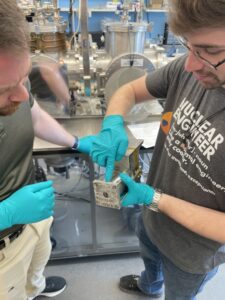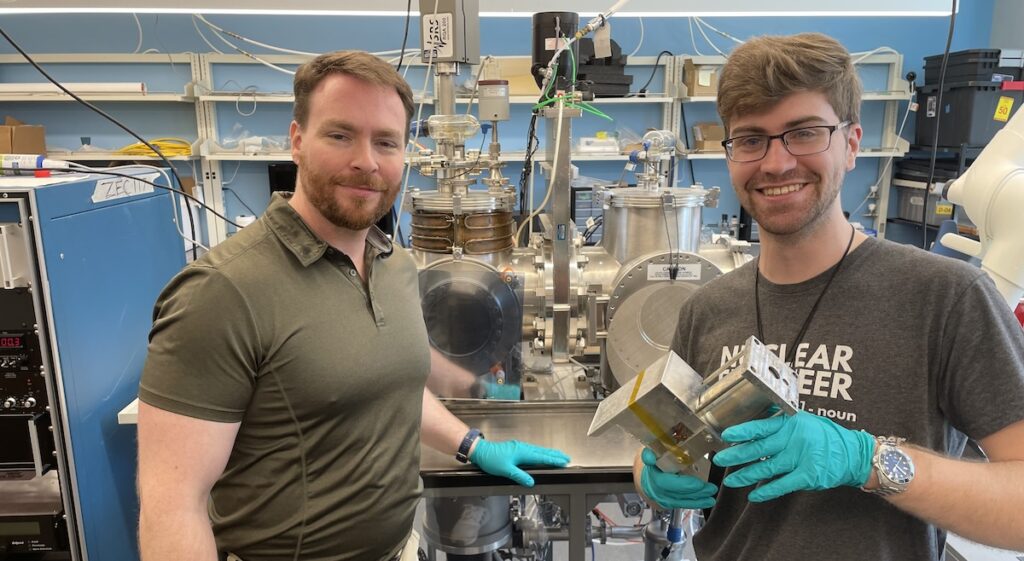Nuclear Engineering Zinkle Fellow and Associate Professor David Donovan appreciates all the advances in technology that allow him to stay in touch with colleagues and research collaborators from afar. Yet, nothing replaces face-to-face meetings.
Donovan recently traveled to San Diego for seven weeks to spend time at the DIII-D National Fusion Facility at General Atomics. The trip is part of his faculty development leave this semester. Having the chance to exchange ideas with scientists and spend hours in an office with someone on the whiteboard was intellectually stimulating and generated many organic ideas that likely wouldn’t have resulted otherwise.
 “It gave me the chance to re-engage with my research more fully and spend a long period of time to just discuss science, talk about proposals, and work through ideas with colleagues to plan future work,” Donovan said. “It’s a chance to work with another group of people and flush out ideas that you just can’t do over Zoom or email as effectively.”
“It gave me the chance to re-engage with my research more fully and spend a long period of time to just discuss science, talk about proposals, and work through ideas with colleagues to plan future work,” Donovan said. “It’s a chance to work with another group of people and flush out ideas that you just can’t do over Zoom or email as effectively.”
Donovan has been working on a Department of Energy-funded project with DIII-D for about eight years. Although his research group can work productively from UT’s campus, his trip to San Diego allowed him to plan new experiments and work on small tasks that will be advantageous in the future.
“One of the biggest benefits was the chance to work closely with UT Research Assistant Professor Jun Ren, who has worked on site in San Diego for six years, and our UT postdoc, Bingzhe Zhao,” Donovan said. “We worked on the development of a new diagnostic we are building for use on DIII-D to measure the energy of ions that are impacting the wall of the fusion device.”
The ion energy distribution at the wall of the fusion device is very important for, among other things, understanding the rate at which the wall materials will erode or heat up, which informs how scientists can operate safely to maintain the health of the device.
Zhao is improving the design of a gridded ion energy analyzer that must be able to withstand the intense heat flux of the fusion plasma at the wall, which can exceed the heat at the tip of a rocket nozzle entering the Earth’s atmosphere. This project in San Diego connects to work done on campus using a compact plasma exposure experiment in the Zeanah Engineering Complex to test out features of the design, which is led by UT graduate student, Mason Phillips.
During the meetings, Donovan and Zhao discussed finding a vendor with the ability to laser cut tungsten at a specific measurement. They had spoken with multiple vendors already. But through conversations in San Diego, they discovered a group that happened to be a few hundred feet away.
“We looked all over the world to get these different quotes and then walked across the parking lot and found the right match,” Donovan said. “Sometimes you just have to talk it out and figure out who does what. That is what these sabbaticals enable you to do.”
Donovan returned from his stay in San Diego refreshed and reinvigorated. He was able to step back and look at the bigger picture, and the diversity of thought he encountered pushed him closer to some of his research goals.
“We have a plenty of communication tools at our disposal to interact with people around the world any time we like, and that has enabled lots of new opportunities to expand our understanding,” Donovan said. “But sometimes you need to physically put yourself in a different environment in order to provide fresh perspective and insight and allow free flowing discussions with colleagues. We have to come together to actually discuss our thoughts, and by combining them, we have better outcomes.”
Contact
Rhiannon Potkey (865-974-0683, rpotkey@utk.edu)
